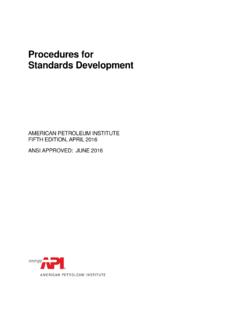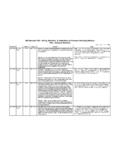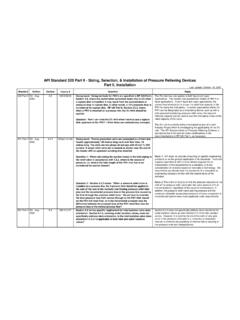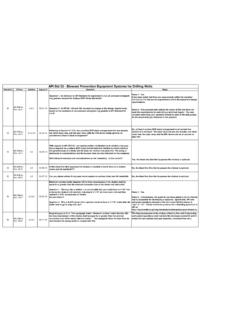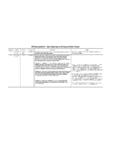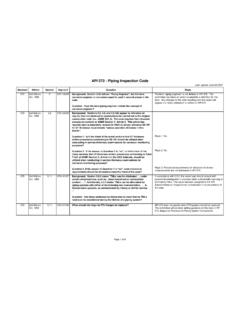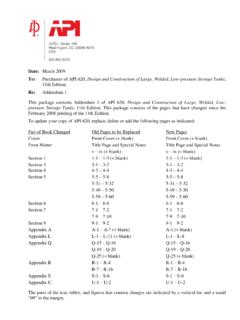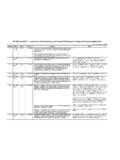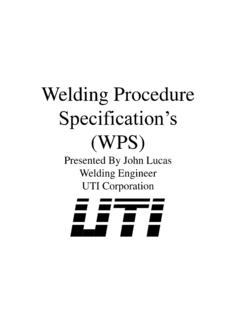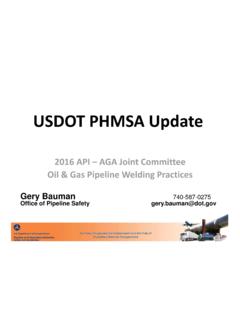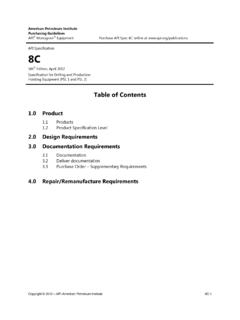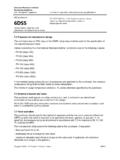Transcription of Improving API 1104 for the Twenty-second Edition …
1 DNV GL 2014 SAFER, SMARTER, GREENERDNV GL 2014 Improving API 1104 for theTwenty- second Edition1 API-AGA Joint Committee on Oil and Gas Pipeline Field welding PracticesBill Bruce SecretaryJanuary 17-19, 2017 JW Marriott Austin Austin, TexasDNV GL 2014 Introduction Twenty-second Edition of API 1104 is nominally scheduled for 2018 September 2013 ( twenty -first Edition ) plus five years Incremental improvements to the standard are developed at annual meeting and throughout the year by various subcommittees and task groups Important to occasionally step back and think about where we want to go with the standard in the long term , are we addressing emerging trends? Opportunities for improvement to address two emerging trends will be level of ambiguity discussed at January 2016 weld strength matching Weld metal strength vs. strength of pipe material in axial direction Heat-affected zone (HAZ) softening Open discussion pertaining to other opportunities2 DNV GL in API 1104 discussed at January 2016 meeting API 1104 contains quite a bit of ambiguity For welding procedure qualification (and welder qualification) in particular , contains no guidance on what to specify on a welding procedure specification (WPS) in relation to what was used to make the test weld Two schools of thought on this Allows flexibility for the user Creates confusion during audits Regulatory oversight has increased significantly in recent years Operators continue to reported issues as the result of ambiguity and differences in opinion it creates with regard to the intent of some of the requirements Violations of and ( welding procedures )
2 Are often cited in notice of probable violations (NOPVs) ..must be recorded in in above and ..detailsof each qualified procedure shall be in of API 1104 are often cited We should do what we can to reduce ambiguity in the next Edition of API 11043 DNV GL 2014 Interpretations Task Group/Database API 1104 committee receives many requests for interpretation Intent for some requirements in API 1104 is contained in the interpretations database , database contains a number ofinterpretations that address what to specifyon a WPS with regard to what was used tomake the test weld Interpretations database was a primaryresource in the development of the PRCI guidance document for API 1104 But, guidance document is not partof API 1104, is not sanctioned by API,and its existence is unknown to mostusers of API 1104 We should use interpretations process anddatabase as basis for improvements4 DNV GL 2014 New ITG Ground Rules Requests for interpretation (particularly multiple requests about the same issue) are often a good indicator of an opportunity for improvement New ITG ground rules include a requirement to provide feedback to the relevant responses to the request must be developed with respect to what the standard currently saysand not what was intended.
3 Note that intent may be a driver to forming a response only if the document language is not clear or the standard should (or meant to) saycan also be discussed, but this must not influence the response. This discussion can be used as a basis for future improvements/revisions to the standard. A record of these potential improvements/revisions shall be provided to the relevant subcommittee chairs. ITG is now comprised of subcommittee chairs (since 2013) Formerly Modifications, Interpretation, and Policy Subcommittee5 DNV GL 2014 Previous Request for Interpretation and Response Question Paragraph states that "A change in the range for speed of travel constitutes an essential variable." and requires that the procedure be requalified if this range is changed. How is the range of travel speed for each pass established? A) By measuring the travel speed of each pass during procedure qualification and listing the exact speeds employed by the welder for each pass.
4 B) By establishing a reasonable range of travel speeds based on experience and/or experimentation at the filler metal manufacturers recommended amperage and voltage ranges and welding the procedure qualification coupon within that specified range. C) By some other method (Please explain). Answer The Company establishes the range that they feel is appropriate and one way is as you have suggested in B. 6 DNV GL 2014 What Can We Do to Convey Intent? These interpretation responses represent the intent of the committee A certain degree of flexibility is required in API 1104 Some pipelines are more high risk than others Generic procedures qualified to go in a welding manual Project specific procedures API 1104 needs to be scalable What can we do to convey the intent of the committee in the standard? Clarify the requirement in the standard itself?
5 Use a tiered approach? Leave as-is for less-critical applications? Supplemental essential variables and tighter allowable ranges for more-critical applications ( , for project specific applications)? Provide guidance note(s) after the requirement? Provide guidance in a commentary section or companion document?7 DNV GL 2014 How Do We Reduce Ambiguity? What improvements can we make toreduce ambiguity? , travel speed is an essential variable forprocedure qualification, yet ironically, whatAPI 1104 provides as an example procedurequalification record (PQR) does not even havea place to record travel speed Figure 2 Sample Coupon Test Report The lack of guidance on what to specify on aWPS with regard to what was used to makethe test weld, combined with the ability tospecify a very wide range (and the thought ofincreased regulatory oversight) encouragesusers to specify very wide ranges May be allowed May prevent welding outside the qualified range May not be technically sound for some applications8 DNV GL 2014 Additional Opportunities for Improvement Travel speed is an essential variable for procedure.
6 But amps and volts are not (can be changed to any value without requalification Main body of API 1104 does not consider the concept of heat input, whichtakes into account the collective effect of amps, volts, and travel speed ofthe resulting thermal cycle of the weld It is time to recognize heat input as optional essential variable to travel speed Preheat temperature only says the preheat temperature at the start of the weld shall be specified What is the start of the weld ? Does that mean the start of the root bead only, each weld bead, the start of each layer of weld metal, or? It is time to introduce interpass temperature We refer to AWS in API 1104 AWS will allow us to reproduce critical definitions9 DNV GL 2014 Another Example of Ambiguity Changes to an essential variable outside the range qualified requires that the procedure be requalified A welding procedure shall be reestablished as a new welding procedure specification and shall be completely requalified when any of the essential variables listed in are changed.)
7 What does completely requalified mean? Presumably it involves making and testing a new test weld, but why? If the new range could have been specified initially (based on the original test weld), why require that a new test weld be made? Can I write a new WPS based on an old existing test weld? What significance does the concept of an essential variable have if the company can specify anything they think is appropriate, regardless of what was used to make the test weld?10 DNV GL 2014 New Example of Ambiguity Multiple welder qualification to says For the second test, the welder shall lay out, cut, fit, and weld a branch-on-pipe PHMSA has reportedly argued recently that the use of a saddle cutting beveling machine is not be allowed This was the subject of a request for interpretation in 2001 Question ..does layout mean: 1. The welder shall layout the branch connection from scratch (using wraparounds, steel squares, or any tools necessary)?
8 2. The welder can layout the branch connection utilizing a precut template? Answer The decision as to the method of layout is left to the company. 11 DNV GL Weld Strength Matching Many changes in the pipeline industry have occurred over the past few decades Higher-strength line pipe steels High-productivity mechanized gas-metal arcwelding equipment (dual torch, tandem arc, etc.) Inspection using automated ultrasonic testing (AUT) Many of the construction practices that wereused prior to these changes are still used today Conventional stove-pipe welding methods ( , usingcellulosic-coated electrodes) Inspection using radiographic testing (RT) Even for modern pipelines, tie-in and repair weldsare often made using conventional methodsDNV GL 201413 Recent Pipeline Construction Quality Issues Pipeline girth weld failures continue to occur in North America Some in newly-constructed pipeline during pre-service hydrostatic proof testing Advisory Bulletin was issued by the US DOTP ipeline and Hazardous Materials SafetyAdministration (PHMSA) that highlights theseand other issues (ADB 10 03) Contributing factors include.
9 High-low misalignment Unequal-wall-thickness transitions High longitudinal stress/strain associated withlifting and lowering-in practices Inadequate tie-in and repair welding procedures Improper inspection and delay times Insufficient adherence to qualified welding procedures Recently-completed project at DNV GL for Pipeline Research Council International (PRCI) addressed these issuesDNV GL 2014 Girth Weld Strength Matching The rate of pipeline incidents (leaks and ruptures) attributed to defective girth welds has traditionally been low Axial stresses ( , those perpendicular to girth welds) frompressure loading are significantly lower in a completedpipeline than those in the circumferential (hoop stress)direction Axial stresses in completed girth welds Occur during lifting and lowering-in Occur when the pipeline does not fit the ditch Some strain capacity can be exhausted by exceedingelastic limit during lifting and lowering-in Particularly at undermatching strength girth welds Undermatching strength girth welds can be due to.
10 Pipe strength in axial direction is greater than weld metalstrength Softening in the heat-affected zone14 DNV GL 2014 Two Recent PHMSA Advisory Bulletins ADB 09 01 Potential Low and Variable Yield and Tensile Strength and Chemical Composition Properties in High Strength Line Pipe Following the discovery of suspected understrength line pipe ADB 10 03 Girth Weld Quality Issues Due to Improper Transitioning, Misalignment, and welding Practices of Large Diameter Line Pipe Following girth weld failures during new construction activities Since ADB 09 01 (low and variable yield strength), trend for as-received line pipe strength levels has been toward the higher end of the acceptable range Manufacturers aiming higher to account for variability in tensile testing practices by third-party labs (flattening procedure, Bauschinger effect, extensometer placement, etc.)
